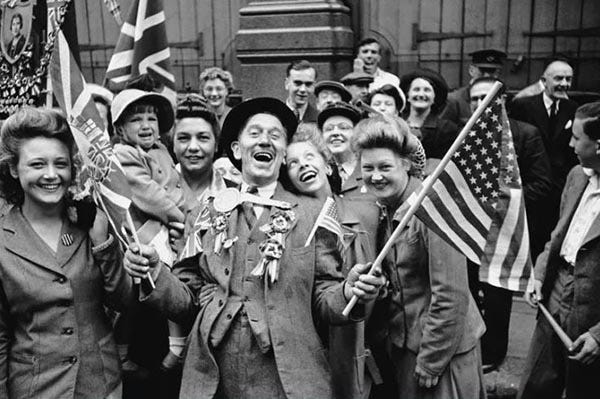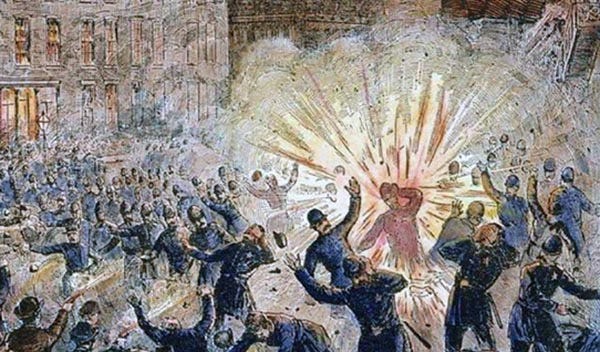🌷 What Hath the Month of May Wrought?
May has been a historically violent month, and we headed to the moon. Here's the skinny on our fifth month.
Away we go!
Let’s see what interesting events May has brought us historically. Turns out it’s a very violent month and us headed to the moon.
May 4, 1886, The Haymarket Affair
The Haymarket Affair, also known as the Haymarket Riot, was a violent confrontation between police and labor protesters in Chicago on May 4, 1886, that became a symbol of the international struggle for workers' rights. It occurred on May 1, 1886, during a labor demonstration in Haymarket Square, Chicago. The protest was part of a nationwide campaign advocating for an eight hour week.
During the peaceful demonstration, a bomb was thrown into the crowd, resulting in chaos and violence. In the aftermath, several police officers and civilians were killed or injured. The incident led to a crackdown on labor activists and the arrest of numerous individuals associated with the labor movement, including several prominent anarchists.
The Haymarket affair had far-reaching consequences. It sparked a wave of anti-labor sentiment and government repression against labor organizations and activists. Eight anarchists were eventually convicted of conspiracy, though evidence linking them to the bombing was scant. Four of them were executed, while one committed suicide in prison. The remaining three were eventually pardoned.
Despite the tragedy of the event, the Haymarket affair galvanized the labor movement and served as a rallying cry for workers' rights. It solidified May 1st as International Workers' Day, commemorated by labor activists worldwide to honor the struggles and achievements of the labor movement.
Socialist bums!
May 7-8, 1945, Victory in Europe Day

May 7-8, 1945, marked Victory in Europe (VE) Day, a momentous occasion signaling the end of World War II in Europe. On May 7, 1945, German officials signed the unconditional surrender documents in Reims, France, effectively ending the war on the Western Front. The surrender came into effect on May 8, 1945, and was officially celebrated as VE Day.
The news of the German surrender ignited jubilant celebrations across Europe and beyond. People flooded the streets, rejoicing and expressing relief that the long and devastating conflict was finally over.
As a side note, May 9th is Victory Day, in Russia commemorating the surrender of Nazi Germany in 1945, ending the Great Patriotic War, known as World War II to us. It's a day of remembrance, reflection, and honoring the sacrifices made by the 26 to 27 millions of killed Soviets during the war against Hitler’s Nazis. Of course we don’t acknowledge their contributions to actually winning the war because…
they’re Commie bastards!
May 4, 1970 Kent State Massacre
At Kent State University, four students - Allison Krause, 19; Sandra Lee Scheuer, 20; Jeffrey Glenn Miller, 20; and William K. Schroeder, 19 - were killed by National Guardsmen who opened fire on a crowd of 1,000 students protesting President Richard Nixon's decision to invade Cambodia. Eleven others were wounded. The shootings set off tumultuous campus demonstrations across America resulting in the temporary closing of over 450 colleges and universities
May 6, 1527 - The Renaissance Ended with the Sack of Rome

The Renaissance ended with the Sack of Rome by German troops as part of an ongoing conflict between the Hapsburg Empire and the French Monarchy. German troops killed over 4,000 Romans, imprisoned the Pope, and looted works of art and libraries. An entire year passed before order could be restored in Rome.
It marked a significant turning point in the history of the Renaissance. The conflict between the Habsburg Empire and the French monarchy, along with the involvement of other Italian states, contributed to the chaos and devastation witnessed during the sack.
The brutal attack led by German troops, mercenaries, and Spanish soldiers resulted in widespread destruction, loss of life, and the plundering of precious artworks and cultural artifacts. The Pope at the time, Clement VII, was even captured and held prisoner, adding to the turmoil.
The Sack of Rome stands as a stark reminder of the fragility of civilization and the vulnerability of cultural heritage in times of conflict. If it happened to Rome, it can happen to us and probably will. Tough guys do fall.
May 18, 1998, Microsoft Anti-Trust Case

In one of the biggest antitrust lawsuits of the 20th century, American software giant Microsoft Corporation was sued by the U.S. Federal government and 20 state governments charging the company with using unfair tactics to crush competition and restrict choices for consumers. The lawsuits alleged Microsoft used illegal practices to deny personal computer owners the benefits of a free and competitive market and also alleged Microsoft extended its monopoly on operating systems to "develop a chokehold" on the Internet browser software market.
One of the rare events where consumers won, and possibly one of the last. No more monopoly busting for us.
May 25, 1787: The American Constitutional Convention
The Constitutional Convention began in Philadelphia, leading to the drafting of the United States Constitution, which apparently doesn’t mean much any more as we are surveilled by dozens of secret Government institutions, and first amendment rights are a joke.
May 25, 1961: Kenedy Announces Going to the Moon
President John F. Kennedy announced the goal of sending an American to the Moon before the end of the decade. We all shook our head and said to ourselves, “Yeah, sure!” but damn, but we did it.
It took some work though. The American space programs encompass a range of initiatives and missions conducted by NASA (the National Aeronautics and Space Administration) and other organizations. Some of the key American space programs included:
1. Mercury Program (1958-1963):
The first manned spaceflight program by the United States.
Goal: to put a human in orbit around Earth.
Achieved the first American manned spaceflights, including Alan Shepard's suborbital flight (Mercury-Redstone 3) and John Glenn's orbital flight (Friendship 7).
2. Gemini Program (1961-1966):
Followed the Mercury program and focused on developing techniques for space travel and rendezvous.
Conducted longer-duration missions and spacewalks.
Played a crucial role in preparing for the Apollo program.
3. Apollo Program (1961-1972):
Goal: to land humans on the Moon and bring them back safely to Earth.
Achieved six successful manned Moon landings between 1969 and 1972 (Apollo 11, 12, 14, 15, 16, 17).
Neil Armstrong and Buzz Aldrin became the first humans to walk on the Moon during Apollo 11 in 1969.
Gave us Apollo 13, the movie. Great pic!
NASA continued with Skylab Program (1973-1974), America's first space station program.
The Space Shuttle Program (1981-2011) Reusable spacecraft system designed for various missions including satellite deployment, space station assembly (International Space Station), and scientific research.
The International Space Station (ISS): A collaborative program involving NASA, Russia's Roscosmos, ESA (European Space Agency), JAXA (Japan Aerospace Exploration Agency), and CSA (Canadian Space Agency).
Artemis Program (Ongoing) NASA's current program aimed at returning humans to the Moon, including the first woman and the next man.
In other words, “To The Moon, Alice!”






Thanks Bill! It is amazing for good and for evil.
Good read Lou thanks…amazing what man can do .